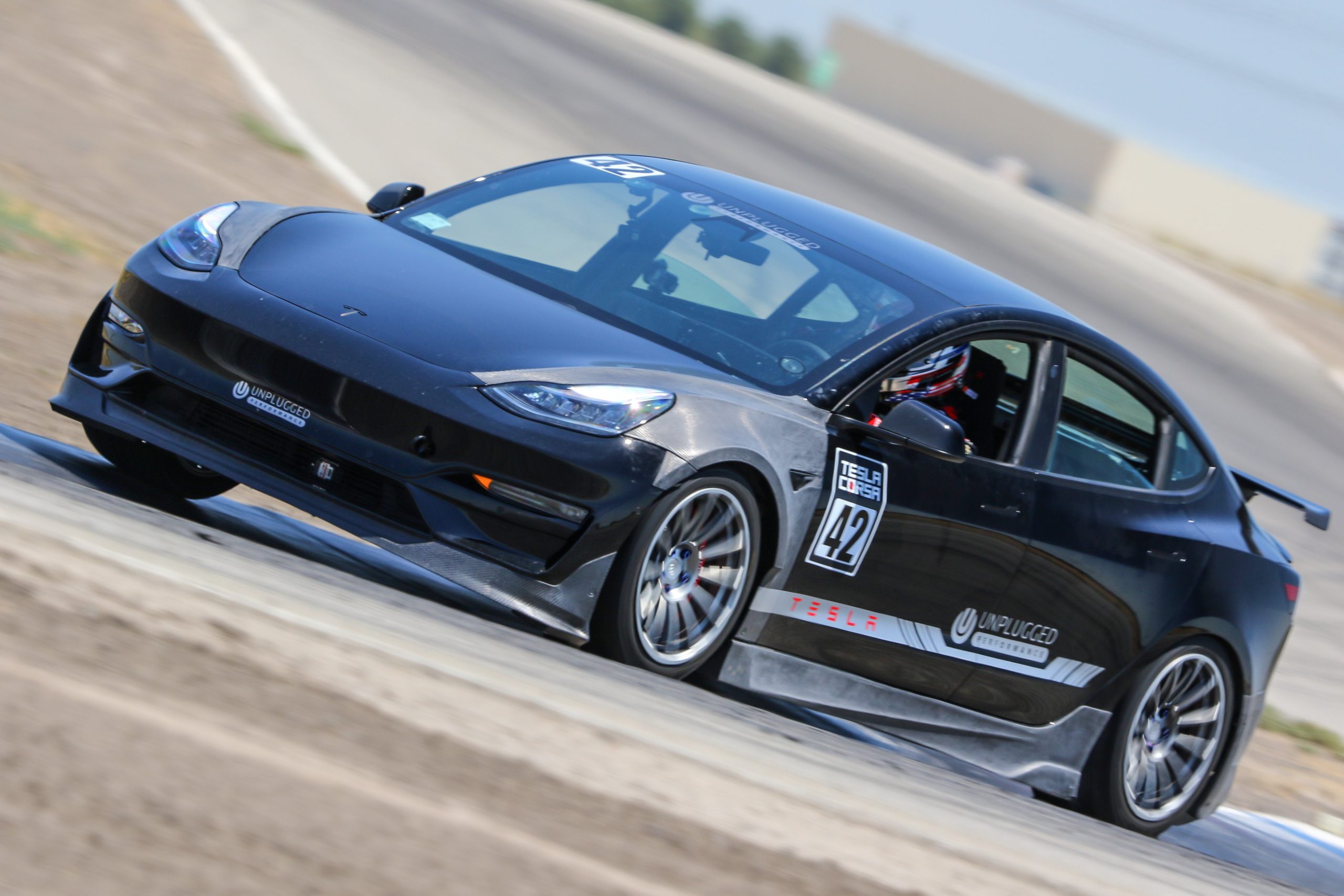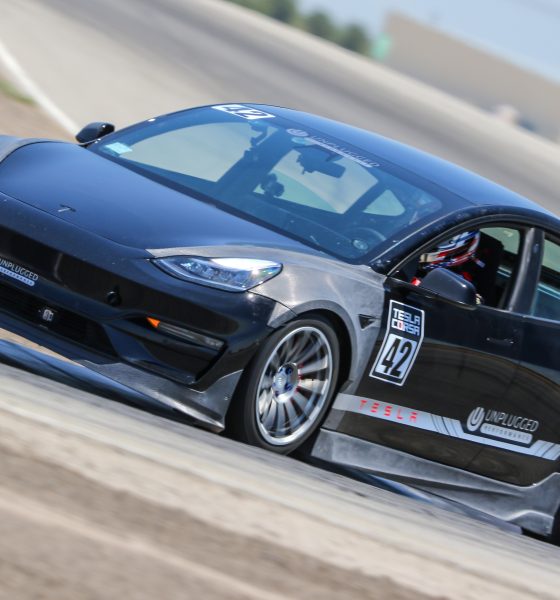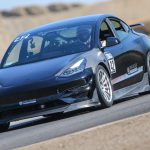

News
Unplugged Performance Tesla Model 3 sets record ahead of Pikes Peak attempt
The Tesla Model 3 Performance is already a track weapon straight out of the factory. With Track Mode, a stock Model 3 Performance could completely dominate high performance sedans on the closed circuit. But with special parts that are designed to increase the vehicle’s track capability even further, the Model 3 Performance becomes something that is downright frightening.
Around two weeks ago, Tesla aftermarket specialist and tuning house Unplugged Performance announced its entry to the esteemed Pikes Peak International Hill Climb with legendary racer driver Randy Pobst behind the wheel. Pobst is the perfect driver for such an event, considering that he was directly involved with Tesla’s creation of the Model 3 Performance’s Track Mode. With Pobst behind the wheel, Unplugged Performance’s Model 3 has the potential to complete the Pikes Peak Hill Climb, and possibly surprise a number of critics along the way.
Interestingly enough, the Unplugged Performance team did not have a car for the event when it made its Pikes Peak Hill Climb announcement. Such a vehicle was only picked up on the night of July 17, and later equipped with the company’s Ascension R package. Unplugged Performance’s Ascension R kit made its debut with Tesla owner enthusiast Erik Strait’s Model 3, which was sent to Japan earlier this year. Strait’s vehicle, the first of the company’s Ascension R units, set records in Japan during its brief stay in the country.
- Tesla Model 3 equipped with Unplugged Performance’s Ascension R package. (Credit: Unplugged Performance)
- Tesla Model 3 equipped with Unplugged Performance’s Ascension R package. (Credit: Unplugged Performance)
Tesla Model 3 equipped with Unplugged Performance’s Ascension R package. (Credit: Unplugged Performance)
The Model 3 picked up by the Unplugged Performance team on July 17 would become the company’s second Ascension R unit. The modification of the Model 3 Performance would begin on July 20 and end on Fright night, July 24. With the car completed, the team drove over to Buttonwillow on Autopilot to ensure that the trip was as safe as possible. At around 2 a.m. on July 25, the Model 3 Ascension R took its first charge. Interestingly enough, July 25 also happened to be the day of TeslaCorsa 9, an event where Tesla owners get together for a day on the track.
In a message to Teslarati, the Unplugged Performance team stated that they did not really expect the freshly modded Model 3 to set new records right out of the bat. The vehicle’s driver, Oscar Jackson Jr., after all, has never driven a Tesla prior to the event. Jackson was used to racing vehicles like the Porsche GT3 RS, but he did not have any experience with high performance EVs stepping into the Model 3. It was then surprising to see that before lunchtime, Unplugged Performance’s Model 3 Ascension R broke the record for fastest production Tesla on street tires on the Buttonwillow track, running a 1:54.266 on 200 tread wear tires.
What was even more interesting was that later during the day, the Model 3 recorded an even more impressive lap despite its battery being halved. The team equipped the Model 3 with Pirelli slicks, and the vehicle ended up running a 1:53.277 lap despite a 50% state of charge. In a statement following his experience, Jackson, noted that he was incredibly impressed with the Tesla Model 3. According to the racer, the Model 3 was already a great car from the factory, but with an additional boost from Unplugged Performance’s parts, the vehicle had the potential to rival even the best track weapons available today.
- Tesla Model 3 equipped with Unplugged Performance’s Ascension R package. (Credit: Unplugged Performance)
- Tesla Model 3 equipped with Unplugged Performance’s Ascension R package. (Credit: Unplugged Performance)
Tesla Model 3 equipped with Unplugged Performance’s Ascension R package. (Credit: Unplugged Performance)
“It was a pretty mind blowing experience to have this be my first time driving a Tesla. Despite it being a shakedown day for Unplugged’s latest build, the car was surprisingly well sorted and it inspired immediate confidence. The brakes in particular were a big surprise given that the car is a lot heavier than what I’m used to racing with. Unplugged’s “BFB” carbon ceramic kit allowed me to brake deep into the corner and I found myself using braking points comparable to what I use when racing the Porsche GT3 RS and spec Miatas!
“The car was already really well prepared so we did not need to change much. The suspension was great off the bat and really well dialed-in. As the day progressed, we simply raised the rear up a little and added a bit more compression. Since the car was factory power and factory traction control I found myself being interrupted by the car’s nannies… Overall the car is a rocket ship (no SpaceX pun intended)! If I had more time with it I’m certain I can go a lot faster. I’m looking forward to my next time behind the wheel of it!” he said.
Watch a rather entertaining run of Unplugged Performance’s Model 3 Ascension R in the video below.

News
Tesla FSD fleet is nearing 7 billion total miles, including 2.5 billion city miles
As can be seen on Tesla’s official FSD webpage, vehicles equipped with the system have now navigated over 6.99 billion miles.

Tesla’s Full Self-Driving (Supervised) fleet is closing in on almost 7 billion total miles driven, as per data posted by the company on its official FSD webpage.
These figures hint at the massive scale of data fueling Tesla’s rapid FSD improvements, which have been quite notable as of late.
FSD mileage milestones
As can be seen on Tesla’s official FSD webpage, vehicles equipped with the system have now navigated over 6.99 billion miles. Tesla owner and avid FSD tester Whole Mars Catalog also shared a screenshot indicating that from the nearly 7 billion miles traveled by the FSD fleet, more than 2.5 billion miles were driven inside cities.
City miles are particularly valuable for complex urban scenarios like unprotected turns, pedestrian interactions, and traffic lights. This is also the difference-maker for FSD, as only complex solutions, such as Waymo’s self-driving taxis, operate similarly on inner-city streets. And even then, incidents such as the San Francisco blackouts have proven challenging for sensor-rich vehicles like Waymos.
Tesla’s data edge
Tesla has a number of advantages in the autonomous vehicle sector, one of which is the size of its fleet and the number of vehicles training FSD on real-world roads. Tesla’s nearly 7 billion FSD miles then allow the company to roll out updates that make its vehicles behave like they are being driven by experienced drivers, even if they are operating on their own.
So notable are Tesla’s improvements to FSD that NVIDIA Director of Robotics Jim Fan, after experiencing FSD v14, noted that the system is the first AI that passes what he described as a “Physical Turing Test.”
“Despite knowing exactly how robot learning works, I still find it magical watching the steering wheel turn by itself. First it feels surreal, next it becomes routine. Then, like the smartphone, taking it away actively hurts. This is how humanity gets rewired and glued to god-like technologies,” Fan wrote in a post on X.
News
Tesla starts showing how FSD will change lives in Europe
Local officials tested the system on narrow country roads and were impressed by FSD’s smooth, human-like driving, with some calling the service a game-changer for everyday life in areas that are far from urban centers.

Tesla has launched Europe’s first public shuttle service using Full Self-Driving (Supervised) in the rural Eifelkreis Bitburg-Prüm region of Germany, demonstrating how the technology can restore independence and mobility for people who struggle with limited transport options.
Local officials tested the system on narrow country roads and were impressed by FSD’s smooth, human-like driving, with some calling the service a game-changer for everyday life in areas that are far from urban centers.
Officials see real impact on rural residents
Arzfeld Mayor Johannes Kuhl and District Administrator Andreas Kruppert personally tested the Tesla shuttle service. This allowed them to see just how well FSD navigated winding lanes and rural roads confidently. Kruppert said, “Autonomous driving sounds like science fiction to many, but we simply see here that it works totally well in rural regions too.” Kuhl, for his part, also noted that FSD “feels like a very experienced driver.”
The pilot complements the area’s “Citizen Bus” program, which provides on-demand rides for elderly residents who can no longer drive themselves. Tesla Europe shared a video of a demonstration of the service, highlighting how FSD gives people their freedom back, even in places where public transport is not as prevalent.
What the Ministry for Economic Affairs and Transport says
Rhineland-Palatinate’s Minister Daniela Schmitt supported the project, praising the collaboration that made this “first of its kind in Europe” possible. As per the ministry, the rural rollout for the service shows FSD’s potential beyond major cities, and it delivers tangible benefits like grocery runs, doctor visits, and social connections for isolated residents.
“Reliable and flexible mobility is especially vital in rural areas. With the launch of a shuttle service using self-driving vehicles (FSD supervised) by Tesla in the Eifelkreis Bitburg-Prüm, an innovative pilot project is now getting underway that complements local community bus services. It is the first project of its kind in Europe.
“The result is a real gain for rural mobility: greater accessibility, more flexibility and tangible benefits for everyday life. A strong signal for innovation, cooperation and future-oriented mobility beyond urban centers,” the ministry wrote in a LinkedIn post.
News
Tesla China quietly posts Robotaxi-related job listing
Tesla China is currently seeking a Low Voltage Electrical Engineer to work on circuit board design for the company’s autonomous vehicles.

Tesla has posted a new job listing in Shanghai explicitly tied to its Robotaxi program, fueling speculation that the company is preparing to launch its dedicated autonomous ride-hailing service in China.
As noted in the listing, Tesla China is currently seeking a Low Voltage Electrical Engineer to work on circuit board design for the company’s autonomous vehicles.
Robotaxi-specific role
The listing, which was shared on social media platform X by industry watcher @tslaming, suggested that Tesla China is looking to fill the role urgently. The job listing itself specifically mentions that the person hired for the role will be working on the Low Voltage Hardware team, which would design the circuit boards that would serve as the nervous system of the Robotaxi.
Key tasks for the role, as indicated in the job listing, include collaboration with PCB layout, firmware, mechanical, program management, and validation teams, among other responsibilities. The role is based in Shanghai.
China Robotaxi launch
China represents a massive potential market for robotaxis, with its dense urban centers and supportive policies in select cities. Tesla has limited permission to roll out FSD in the country, though despite this, its vehicles have been hailed as among the best in the market when it comes to autonomous features. So far, at least, it appears that China supports Tesla’s FSD and Robotaxi rollout.
This was hinted at in November, when Tesla brought the Cybercab to the 8th China International Import Expo (CIIE) in Shanghai, marking the first time that the autonomous two-seater was brought to the Asia-Pacific region. The vehicle, despite not having a release date in China, received a significant amount of interest among the event’s attendees.












